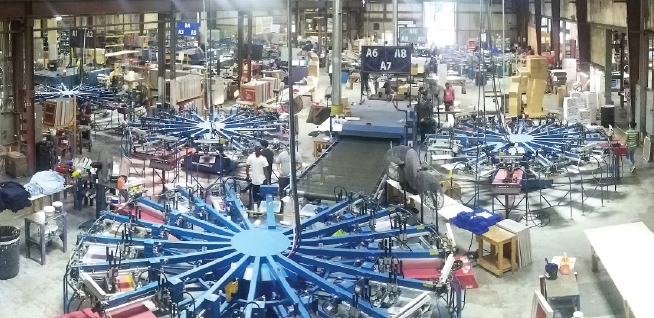Tips and How-To
MIS: Whipping Your Data into Shape
Whatever form it takes, a management information system should be the central data repository for your business.
Published
7 years agoon

![]() In The Automation Issue, we present a collection of expert essays on an important topic in the industry today. Here, Eileen Fritsch discusses MIS automation.
In The Automation Issue, we present a collection of expert essays on an important topic in the industry today. Here, Eileen Fritsch discusses MIS automation.
Once upon a time, a certain print company was able to triple its business after implementing a management information system (MIS) and integrating all of its web-to-print storefronts. The investment transformed the business. For one thing, the automation calmed the chaos associated with manually processing orders for fast-turnaround, shorter-run jobs. Harried customer service employees were no longer unconsciously giving customers the impression the company just couldn’t handle any more orders. By fully relying on their MIS, the shop ran more smoothly and its leadership team was able to devote more time to thinking strategically about the future of the business.
This example, a client of consultant Jennifer Matt of Web2Print Experts, is proof that some MIS implementation stories do have happy endings. Unfortunately, many MIS adoption projects turn into horror stories. Some take more than two years to get up and running; others are never fully implemented at all. Some MIS features go unutilized because they don’t fit with the printer’s existing workflow. Many companies get frustrated and start gathering and analyzing job data manually. Or they decide the software was never a good fit for their workplace before really making an effort to learn how to use all the features. These fears have given automated data a bad name.
This is unfortunate, because a properly implemented MIS will give you all of the data you need to make informed decisions about every aspect of your business. It will give you a competitive edge by enabling you to move faster than your competitors. “You know when you can go up or down in your pricing,” Matt explains, “because you are confident in your cost calculations and your percentage of utilization.” And you’ll even be able to quickly and accurately answer the question that haunts many print shop owners: “Did we make money on that job that just shipped?”
The Evolution of MIS
MIS programs have been around for decades. They became more practical in the 1980s when networked PCs made it possible to gather data from multiple points in a workplace. Early MIS systems helped large manufacturing companies manage the complexities of “just-in-time” automated manufacturing.
The first MIS programs specifically for printing were introduced in the late 1980s, primarily for the largest commercial printing enterprises. MIS programs for smaller printing businesses were introduced in the mid-1990s. But they didn’t really become popular until the big economic slowdown of 2008 and 2009 gave print providers a lot more time to think about the future of their businesses. If firms wanted to stick around, they had to figure out how to cut costs, diversify, and become more efficient at processing a higher volume of shorter-run jobs.
Today, interest in workable print MIS programs is rising because so many B2B customers and consumers expect to be able to place some (or all) of their orders online. The adoption of web-to-print programs means orders will come from a variety of online and traditional sales channels, and multi-piece orders may need to be output on a mix of analog and digital printing equipment. As a result, keeping all job-related data in a centralized database becomes both more complex and more critical for making sound business decisions.
Among younger buyers, digital printing has created an expectation that almost anything can be printed in short runs and with very short turnaround times. This has raised problems for printing companies that remember the good old days, when clients were willing to wait two or three weeks for their orders to be delivered. When longer lead times for bigger print runs were the norm, printing companies could charge more for rush jobs. Today, people expect every printing company to be a quick printer, no matter what type of printing equipment is used.
This has forced all types of printing businesses to take a fresh look at their MIS programs.
“Inefficiencies in your processes come to light much faster when your order volumes double and your run lengths get cut in half,” says Matt. “Doing a lot of manual order processing is not only very inefficient; it can also eat up a large percentage of your profit on smaller jobs.”
MIS for Signs and Graphics
Processing a high volume of shorter-run, customized jobs is nothing new to companies that have used screen printing to produce signs, graphics, and specialty products. Companies that have been in business for generations have adapted to a variety of manufacturing processes over the years.
For example, Mandel Graphic Solutions was founded in 1892 and started out as a wood engraver before evolving to metal photoengraving, prepress film production, offset printing, screen printing, and now large-format digital graphics. Most recently, the shop installed 10-foot-wide direct dye sublimation capabilities.
Like many small companies that have used a succession of production technologies for short runs of custom jobs, Mandel Graphic Solutions developed their own system of managing business information. The company uses QuickBooks for accounting and FileMaker Pro for orders, inventory, and shipping.
According to Rick Mandel, president, Mandel Graphic Solutions is currently developing a web-to-print portal through PressCentric. It will be a standalone system that includes ordering, estimating, and billing while sending data to QuickBooks.
Douglass Screen Printers in Lakeland, Florida, opened their doors in 1939 when hand-lettering was the primary method of making signs. Today, the company has rebranded itself as Dprint and uses a mix of screen printing and digital equipment to produce signs, decals, vehicle graphics, promotional products, and specialty items such as a license plates.
The company is in the process of switching to PrintMatics, an MIS that will integrate with Dprint’s new e-commerce website. Through the myDprint website, customers will be able to choose from over 270 decals, posters, banners, signs, and wall-art graphic designs while having total control over the designs. A separate dynamic platform will be available for designing vehicle wraps.
According to Dprint Production Manager Michael Hickey, their former MIS setup “wasn’t as user-friendly as it needed to be in order for us to become as nimble as we need to be.” PrintMatics is cloud-based, so the shop will be able to get rid of old servers and easily add updates. Hickey also looks forward to moving away from using Excel spreadsheets to manually set production schedules. The new system will automatically place jobs onto the schedule when the stocks needed for production are available.

The operation at Dprint in Lakeland, Florida, is one of many moving parts. The shop uses a cloud-based, integrated system to keep all of their data in line. (Courtesy of Dprint)
In addition, barcode scanning will make it quicker and more efficient for everyone throughout the plant to capture real-time data about functions and inventory. Employees won’t have to go to a terminal to log in their time and record data about each job.
“We want to spend our time on production, not feeding information into software,” says Hickey.
He hopes the new MIS program will free up some time to train employees to become company leaders of the future. Dprint (under its original name) is a Certified Sustainable Green Printing facility, and employee development is one of their continuous improvement initiatives.
MIS for Garment Decoration
One screen printing business reaping the rewards of a well-executed MIS program is C.C. Creations, a high-volume screen printing, embroidery, and promotional products company in College Station, Texas.
C.C. Creations serves over 4200 customers with screen print production of over 5 million impressions annually. With 15 automatic presses working two shifts around the clock, the shop can produce over 35,000 prints a day.
Most of their work comes from corporate clients, but they also sell hundreds of different wearables and gift items to students at Texas A&M University and fans of the school’s Aggies. C.C. Creations operates a retail store called “The Warehouse at C.C. Creations” and an online site devoted to Texas A&M merchandise.
According to Jimmy Turner, president of C.C. Creations, a well-managed MIS program provides an almost limitless amount of useful information. Five years ago, C.C. Creations implemented Impress business management software from Precise Systems, a program designed for companies that use screen printing, embroidery, heat transfer, direct-to-garment printing, and other processes for decorating apparel and promotional products.
Although the system took several months to implement, C.C. Creations is still finding new ways to benefit from the data the system generates. “As we got deeper into it, we started to realize the importance of the data we were getting,” says Turner. “Different individuals from different parts of the company started seeing the value of the data and wondering what else it could do. We’re constantly adding upgrades and customizations."
He says the MIS is a vast improvement over the manual methods they were using in the past. For one thing, they can now track the status of each job without having to make a few phone calls or walk around the plant. Anyone who enters the order number of the job can immediately see whether it’s still in the art department or has made its way into prepress, production, or shipping. Barcode scanning is used to track the progress of the orders throughout the plant, while annotations on each order reduce the risk of special instructions about each job getting lost somewhere during production.

Barcode scanning means real-time production data can be instantly accessed from anywhere. (Courtesy of C.C. Creations)
The management team at C.C. Creations has used reports generated by the MIS to streamline job setup times and print floor operations. They also use it to track requirements and royalty payments for licensed artwork, analyze sales performance in different market segments and territories, and plan strategies for the coming year.
Second-Guessing Is Part of the Process
Reaching the point where you can reap the rewards of good data can be difficult. Turner recalls that after the first 30 days of their MIS implementation, company executives were wondering: “What did we just do?” There were doubts about whether they had chosen the right system and if employees would be willing to change.
Some C.C. Creations employees questioned the need to continually enter data into the system because they believed their old way of working was more efficient. But over time, employees in all departments gradually started to see the value of the system in their own little corners of the printing operation.
Turner emphasizes that “the system is only as good as the information you feed it. If only half your employees are feeding information into the system half the time, it’s not going to do you a lot of good.”
Jennifer Matt’s company, Web2Print Experts, has helped many print service providers make the print MIS implementation process less painful. She says, “Lots of printers want to get it done right, but don’t have the resources to do it.” It’s hard to run a business while focusing on everything it takes to get an MIS program up and running; an implementation project requires detail-oriented, technical people who also understand business. “We bring in those resources to help with the transitions,” says Matt.
Web2Print Experts doesn’t sell any technology, but they are familiar with many different programs and how to integrate web-to-print software with print MIS programs. They often help clients figure out how to use under-utilized features and avoid expensive customizations. Some software vendors may try to convince you that the only way to solve your MIS implementation issues is to switch to their programs. In many cases, that may not be necessary and may simply introduce a different set of problems, says Matt: “It’s very expensive to kick one system out and bring in another.”
But it is also true that no MIS program is perfect. And different programs may actually be better-suited to specific segments of the printing industry. Most print MIS programs today are designed for big commercial printing firms that also want to produce complementary types of large-format graphics. Other MIS programs were developed by companies with in-depth knowledge of workflows for superwide- and grand-format printing, signmaking, apparel decoration, or package printing.
Recommendations for Implementation
Matt says the attitude of the printing business owner is the number-one factor for successful print MIS implementations. It’s not so much about the technology as the execution.
You need to start with a well-defined business strategy that has been clearly communicated to your employees. Your implementation plan should include sufficient resources and meaningful metrics to keep it on target. Your top leadership needs to stay involved throughout the process and encourage employees to really learn the system instead of simply being spoon-fed information during training. Your goal is to have your employees understand how to make the system work better than the vendors do.
Once you’ve made a commitment to an MIS, don’t try to run part of your business outside of it. When you don’t have one, unified system of record, it makes it harder to run your business, says Matt. For example, if your assistant still has to play with job data from different sources for four hours to figure out whether or not you made money on the job, your MIS isn’t really your business system of record.

Another benefit to barcode scanning is the ability to enter data on the spot, saving employees the trip to a logging station. (Courtesy of Dprint)
Instead of trying to “bend” the MIS to make it fit with your workflow, consider adapting your workflow to stay within the parameters of the MIS. Ultimately, it might prove to be a more efficient way of working than methods adopted during the good old days.
If your staff needs to stay focused on production, ask your software vendor to help you get the system up and running instead of simply training your staff how to implement it. If an implementation is only going to happen once, that’s not what your staff needs to know, says Matt. Your staff needs to know how to edit the system to update such things as material costs, pricing, or royalty agreements. When the time comes to integrate new production equipment into your system, you can partner with the software vendor to make it happen.
Jimmy Turner says it’s important to get employees from all departments involved in making the MIS a success. But he recommends designating an individual to serve as the point person for dealing with troubleshooting, upgrades, customizations, and vendor relations.
He also suggests having individuals in each department set some parameters for accessibility. While many employees will need to enter data into the system, the last thing you want is for someone to corrupt or delete data. You need to establish some controls on what parts of the MIS each employee can access.
Implementing an MIS takes a lot of focus and attention to detail. But Matt cautions: “You can’t do it once and ignore it. You have to keep working on it because your business will keep changing. You will add new people, buy new equipment, and adjust your prices for certain customers.”
What’s Next?
Whether your company specializes in graphics, garments, or promotional products, all of these markets will become even more competitive over the next five to seven years. The adoption of high-speed, single-pass inkjet printers with highly automated workflows that include online ordering will put pressure on your company to be as nimble as possible.
In a series of blog posts about the future of the printing industry, Terry Corman of Firehouse (onyx.fire-house.net) predicts that web-to-print software will change how clients interact with their printers: “Order writing, file submission, preflighting, prepress, job quoting, and job tracking can and will be automated.” He believes the front-end costs for doing short-run work will eventually be the same as with long runs.
He also thinks print buyers will want more collaborative relationships with their print vendors and will “cluster around print providers whose software technology best fits their requirements.” Firehouse has developed a customized, customer-facing version of their MIS system. Called “Spark,” the system enables customers to have real-time info on the status of their print projects.
If the long-term vision for your company includes adding a high-speed, single-pass inkjet printer, the MIS you develop today will probably need to integrate with the automated workflows that are required to do short-run, customized jobs on these machines. Keep an eye out for software manufacturers developing end-to-end platforms for workflow automation.
If all the buzz about MIS, JDF integration, and data analytics gives you a pounding headache, take heart. You are not alone – but you are in a position of opportunity. Your customers in brand marketing, corporate environments, and retailing are all facing their own struggles to gather and use data to streamline their operations, cut costs, and become more effective. Establishing yourself as an expert in this area – or simply streamlining one part of the process for them – will give you a leg up that goes beyond the efficiency of your own business.
Eileen Fritsch is a Cincinnati-area-based freelance writer who served as assistant editor of Screen Printing magazine in 1994 before being named a founding editor of Big Picture magazine.

SPONSORED VIDEO
Let’s Talk About It
Creating a More Diverse and Inclusive Screen Printing Industry
LET’S TALK About It: Part 3 discusses how four screen printers have employed people with disabilities, why you should consider doing the same, the resources that are available, and more. Watch the live webinar, held August 16, moderated by Adrienne Palmer, editor-in-chief, Screen Printing magazine, with panelists Ali Banholzer, Amber Massey, Ryan Moor, and Jed Seifert. The multi-part series is hosted exclusively by ROQ.US and U.N.I.T.E Together. Let’s Talk About It: Part 1 focused on Black, female screen printers and can be watched here; Part 2 focused on the LGBTQ+ community and can be watched here.
You may like
Advertisement

Inkcups Announces New CEO and Leadership Restructure

Hope Harbor to Receive Donation from BlueCotton’s 2024 Mary Ruth King Award Recipient

Livin’ the High Life
SUBSCRIBE

Bulletins
Get the most important news and business ideas from Screen Printing magazine's news bulletin.
Advertisement
Latest Feeds
Advertisement
Most Popular
-

 Art, Ad, or Alchemy1 month ago
Art, Ad, or Alchemy1 month agoF&I Printing Is Everywhere!
-

 Case Studies1 month ago
Case Studies1 month agoHigh-Density Inks Help Specialty Printing Take Center Stage
-

 Andy MacDougall1 month ago
Andy MacDougall1 month agoFunctional and Industrial Printing is EVERYWHERE!
-

 Editor's Note1 week ago
Editor's Note1 week agoLivin’ the High Life
-

 Columns2 weeks ago
Columns2 weeks ago8 Marketing Mistakes Not to Make When Promoting Your Screen Printing Services Online
-

 Thomas Trimingham2 months ago
Thomas Trimingham2 months ago“Magic” Marketing for Screen Printing Shops
-

 Marshall Atkinson1 week ago
Marshall Atkinson1 week agoHow to Create a Winning Culture in Your Screen-Printing Business
-

 Press Releases2 months ago
Press Releases2 months agoBig Frog Custom T-Shirts & More of Round Rock Celebrates Grand Opening













